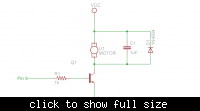amirox
Newbie level 3

Hello everyone,
I am new to electronics. I am using a variation of an arduino board.
I have an LED that is refreshed constantly (I can control the rate in my program,lets say 1000 times a second). Instead of having the LED on or off, it is turned on and off 1000 times a second. of course it looks like it is on to human eye.
I want to drive a fan when the LED is on (well, looks on). Using a transistor (PN2222) and a power supply I tried to connect the legs of LED to the fan with no luck. I am almost sure it doesn't work because the power to LED is cut of 1000 times a second.
Is there any electronic component that I can use to flatten this pulse of power:-|?
I am new to electronics. I am using a variation of an arduino board.
I have an LED that is refreshed constantly (I can control the rate in my program,lets say 1000 times a second). Instead of having the LED on or off, it is turned on and off 1000 times a second. of course it looks like it is on to human eye.
I want to drive a fan when the LED is on (well, looks on). Using a transistor (PN2222) and a power supply I tried to connect the legs of LED to the fan with no luck. I am almost sure it doesn't work because the power to LED is cut of 1000 times a second.
Is there any electronic component that I can use to flatten this pulse of power:-|?

